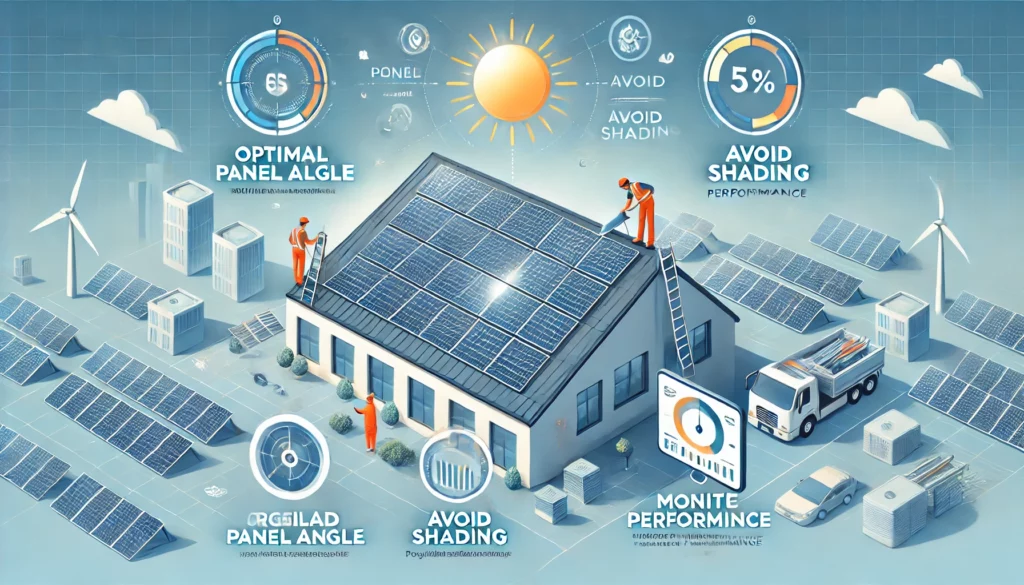Tips for Maximizing Your Solar System’s Efficiency
Once you’ve installed a solar energy system, the next step is to ensure it operates at peak efficiency. Maximizing energy output not only improves your return on investment but also contributes to greater energy independence. Here’s how you can get the most out of your solar panels and system.

1. Optimize the Placement of Solar Panels
The placement of your solar panels significantly impacts their performance.
- Ideal Orientation and Tilt:
Panels should face true south in the northern hemisphere (or true north in the southern hemisphere) for maximum sunlight exposure. The tilt angle should match your latitude to capture the most sunlight throughout the year.
- Avoid Shading:
Even partial shading on a single panel can reduce the system’s overall performance. Regularly trim trees and remove obstructions to maintain clear access to sunlight.
2. Regular Maintenance Is Key
Keeping your system in top condition ensures long-term efficiency.
Clean the Panels:
- Dust, bird droppings, and debris can block sunlight. Clean panels every few months or more frequently in dusty or rainy seasons. Use water and a soft cloth to avoid scratches.
Inspect Connections:
- Check for loose wires, corroded connections, or damage caused by weather.
Monitor Inverter Performance:
- The inverter is the system’s workhorse. Ensure it’s functioning correctly by watching for error codes or unusual behavior.
3. Invest in a Monitoring System
Real-time monitoring allows you to track your system’s energy production and identify issues early.
What to Monitor:
- Daily energy output.
- Seasonal variations in production.
- Alerts for performance anomalies.
Advanced Features:
Some systems provide insights into energy consumption patterns, helping you adjust usage to maximize solar energy reliance.
4. Use Energy Strategically
To maximize savings, align your energy usage with peak solar production hours.
Run Appliances During the Day:
- Use washing machines, dishwashers, and other high-energy appliances when your system is generating the most electricity.
Store Excess Energy:
- If you have a battery system, store energy during the day for nighttime use.
Time-of-Use Tariffs:
- Some regions offer lower electricity rates during off-peak hours. Use stored solar energy when grid rates are high.
5. Upgrade When Necessary
As solar technology advances, upgrading components can significantly boost your system’s efficiency.
Upgrade Panels:
- If your system is older, newer panels with higher efficiency might be worth considering.
Add Battery Storage:
- Installing a battery allows you to store more energy and reduce dependence on the grid.
Smart Inverters:
- Modern inverters come with better optimization and monitoring features.
6. Take Advantage of Incentives and Policies
Local policies can help you save even more with your solar system.
Net Metering:
- Earn credits for excess energy sent to the grid. Check with your utility provider for details.
Tax Credits and Rebates:
- Many governments offer financial incentives for solar installations and upgrades.
Feed-in Tariffs:
- Some regions pay for the solar power you generate and export to the grid.
7. Plan for Seasonal Variations
- Solar energy production varies throughout the year based on weather and sunlight availability.
Winter Months:
- Shorter days mean lower energy production. Clean panels of snow or ice to maximize performance.
Summer Months:
- Peak production occurs, often generating excess energy. Store or sell the surplus to the grid.
8. Work with Professionals
If you notice a drop in efficiency or want to make improvements, consult solar energy professionals for advice.
Annual Inspections:
- A professional check-up can identify issues you might miss.
System Expansion:
- If your energy needs grow, experts can help you add more panels or batteries.
Final Thoughts
Maximizing your solar system’s efficiency requires attention to detail, regular maintenance, and strategic energy use. By following these tips, you can enjoy greater energy savings and a smaller carbon footprint.
Stay tuned for Solar Energy 104, where we’ll explore the environmental and financial impacts of solar energy in depth.
Have questions or success stories about your solar system? Share them in the comments below!